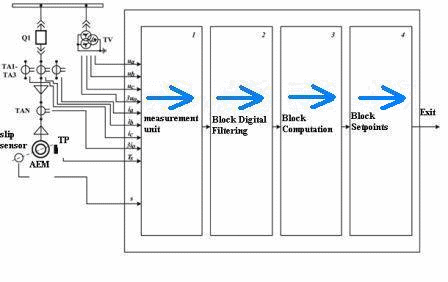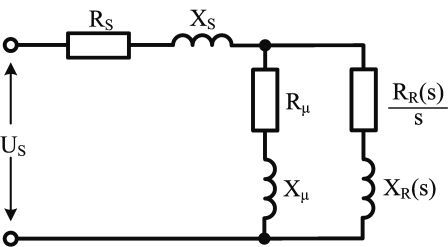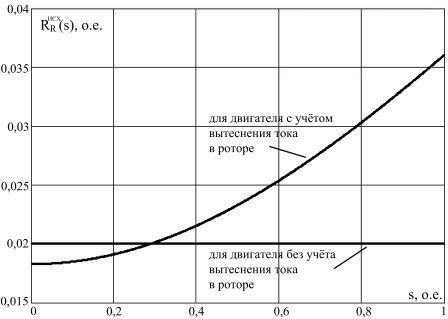

In work mathematical modeling of digital relay protection and automatics of the asynchronous electric motor with a short-circuited rotor are considered. The offered algorithm of protection against a thermal overload of windings of a rotor and stator cars. The technique of measurement of temperature of heating of a rotor is based on calculation in rate of real time of active resistance of a rotor and its comparison with known value in a cold condition.
Induction motors [AEM] squirrel cage are the main mode of electric machines in industrial plants, in the auxiliary thermal and nuclear power plants and consume more than half of all electricity produced. However, the percentage of damaged asynchronous machines is quite high at around 20-25% per annum of the total number in use. Currently, many companies that produce and develop devices of relay protection and automation, giving enough attention to the microprocessor terminals and relays. However, in most modern microprocessor-based platforms for motor protection required Regulations for Electrical [1], transferred to new components with minimal changes and updates without regard to their advanced features. The standard of protection do not provide the correct response on the number of accidents and abnormal modes of operation (overheating of the stator windings and rotor due to malfunction of the cooling system, supply voltage unbalance, technological acceleration, etc.). One way to reduce the cost of repair work is to develop new algorithms for relay protection and automatic AEM squirrel cage. Based on the foregoing, we can conclude that the problem is urgent.
Known thermal overload AEM based on the use of integral dependence of the current stator function of time [2,3]. This protection is implemented in most modern terminals such as REM-545 (group ABB, Sweden), Sepam 1000 + M20 (Schneider Electric, France); UZB-301 (LTD «Novatek-Electro, Russian Federation). In Ukraine, the microprocessor terminals, including the above-mentioned overload protection AEM, produces OAO Електротехнічний plant РелСіС (ACC-01) [4]. However, these methods are inherent disadvantages because of the lack of temperature control heating of the stator windings and rotor. Other approaches implement thermal protection of the rotor should include protection against thermal overheating of the stator and rotor AEM, based on the indirect determination of the temperature of the heating cage rotor [5]. Protection is based on continuous measurement of instantaneous phase currents and voltages, further evaluate linkage and their derivatives, the rotor speed and temperature of stator windings and rotor in excess of allowable values is off the engine from the mains. The disadvantage of this approach is the fact that the temperature of the rotor is determined with great accuracy because of the indirect determination of sliding on the basis of catalog value of the active resistance of the rotor. In this case, protection is provided only for AEM small capacity (up to 200 kW), in which there is no effect of displacement current in the rotor (skin effect), and assuming that the formula for calculating the speed using the catalog of the active resistance of the rotor. Application of the protective algorithm correctly for AEM with glubokopaznym rotor or rotor with a double squirrel-cage (power over 200 kW), in which the resistance of the rotor depends besides the heating temperature and the phenomenon of crowding-out effect of current
Objective: To develop a microprocessor-based protection of induction motors of auxiliary power on the basis of determining the active resistance of the rotor AEM.
-Creation program based on mathematical algorithms protect the induction motor's own needs.
-Creation of the program.
-Tests on real models.
Theoretical studies based on the main provisions of the theory of electrical engineering and electrical modes. Practical researches are based on data obtained from studies in laboratory settings.
The novelty of this paper is that the computation of the heating temperature is in the tempo of real-time by calculating the active resistance of the rotor and its comparison with a known value in the cold state.
This microprocessor-based protection can be used on any plants that use asynchronous motors, with great success, because it provides a greater degree of reliability of electric motors, and prevents their destruction in case of accidents in the network.
As part of evolving security AEM includes standard protection required by Regulations for Electrical [1] (the current cut-off from phase to phase short circuit, earth fault protection, overload protection stator current, undervoltage protection), translated into digital form. The focus is on the development of protection against overheating of the stator and rotor or thermal protection AEM based on the indirect determination of the heating temperature of rotor winding. Calculation of the heating temperature is in the tempo of real-time by calculating the active resistance of the rotor and its comparison with a known value in the cold state.
An algorithm for thermal protection consists of the following main blocks:
• The unit of measurement;
• block digital filtering;
• block calculations;
• block setpoints.
Block diagram of the algorithm for thermal protection is shown in figure 1.
The input of the unit of measurement for the needs of thermal protection algorithm continuously receives signals phase currents (ia, ib, ic) and stress (ua, ub, uc), slip s, the heating temperature of stator windings TS. Analog value with the ADC are converted into digital form. Next, the value of phase currents and voltages are received in block digital filtering based on digital Fourier filter, which are allocated first harmonic [6].

Calculation of the heating temperature of the rotor based on the use of equivalent circuit AED considering the effect of displacement current in the rotor (see figure 2)

In the block computation is done as follows:
• Preliminary steps:
• carry out experiments idling and short-circuit, feeding on the stator three-phase voltage of different frequencies at a stationary car, measuring the initial temperature of the cold condition [7];
• identification of the data of experiments the resistance of the stator windings (RS, XS), branches of the magnetization (R?, X?) and functional relationships of the resistance of the rotor RRish (s) (see Figure 1) Slip at a certain initial temperature of the cold condition TRnach);
The results of the preliminary operations are recorded in a block of constants, located in a block of calculations, and are used in the calculations in real time.
• Operations, made the pace of real time:
• Measurement of phase currents (ia, ib, ic) and stress (ua, ub, uc);
• Measurement of slip s rotor position sensor (DWP), established on the motor shaft;
• Measurement of the heating temperature of stator winding TS; temperature sensor (TD), established in the stator winding engine;

• Evaluation modules of stator current and stator voltage:

• Computation of the generalized current vector of stator and the generalized stress vector of stator:

where

where i, u - the instantaneous current and voltage corresponding phase;
• Calculation of input impedances AEM:

• Adapting the active resistance of stator winding AEM:

where Rs- Temperature coefficient of the conductor stator winding, 1/0S, TS - the current value of the temperature of stator windings, measured by temperature sensors, 0 C;
• Calculation of resistances and conductivities rotor and magnetizing branch:

• Calculation of the conductivities of the rotor:

• Computation of the active resistance of the rotor AEM:

• Calculation of the temperature of the rotor AEM:

After calculating the temperature of the rotor asynchronous machine in the block of computation, the calculated value is compared with setpoint response of thermal protection in the block settings. In case of excess temperature protection setting fires, running a time delay and light alarm overheat the rotor winding. After a time delay produced off the motor from the mains.
An example of simulation of thermal protection AEM manufactured for the engine series AB, with capacity of 630 kW and the stator voltage of 6 kV. Product Information machines are presented in Table 1.
Table 1

The calculated parameters of equivalent circuit for the nominal slip and temperature 750S are shown in Table 2. For modeling used methods of induction motors, as set out in [8]. As an example of a simulated mode protracted starting the engine.


In this paper we analyze the algorithm of microprocessor thermal protection of the asynchronous motor with cage rotor. An improved algorithm for thermal protection of the asynchronous motor with cage rotor, based on the indirect calculation of the heating temperature of the rotor. Calculation of the heating temperature is in the tempo of real-time by calculating the active resistance of the rotor and its comparison with a known value in a cold state, based on measurements of phase currents and voltages, slip and temperature of stator winding. This algorithm is implemented as a program, which includes AEM and the specified protection. The operation of the algorithm in different modes for different types of AEM with different manifestation of the phenomenon of the effect of displacement current in the rotor. Comparison of data obtained in laboratory conditions and using a mathematical model confirm the feasibility of the developed algorithm to protect the AEM from the cage rotor in use.
When writing this abstract the master’s qualification work is not completed. Date of final completion of work: December, 1, 2010. Full text of the work and materials on a work theme can be received from the author or his scientific supervisor after that date.
1. Правила устройства электроустановок/ Минэнерго СССР. – 6-е изд., перераб. и доп. – М.: Энергоатомиздат, 1985. – 640 с.
2. В.А. Андреев. Релейная защита и автоматика систем электроснабжения: Учебник для вузов. 4-е изд. Перераб. и. доп. – М.: Высш. Шк., 2006. – 639 с.
3. Соркинд М.А. Асинхронные электродвигатели 0,4 кВ. Способы защиты от аварийных режимов. Новости электротехники, 2005, №4(34).
4. Официальный сайт ОАО «Електротехнічний завод РелСіС».
5. Патент Украины № 69523 А, МПК 7 Н02Р 5/04, опубл.15.09.2004.
6. Сергиенко А.Б. Цифровая обработка сигналов: Учебник для вузов. 2-е изд. – СПб.: Питер,2006. – 751 с.: ил.
Сергиенко А.Б. Цифровая обработка сигналов
7. ГОСТ 7217-87. Межгосударственный стандарт. Машины электрические вращающиеся. Двигатели асинхронные. Методы испытаний . 2003. - 38 с.
8. Сивокобыленко В.Ф., Лебедев В.К. Переходные процессы в системах электроснабжения собственных нужд электростанций. Уч. пособие, Донецк, ДонНТУ, 2002. – 136 с.
http://masters.donntu.ru/2005/eltf/samarsky/library/st1/st1.htm
9. Способы защиты электродвигателей на примере РКЗ
10. Тепловая защита